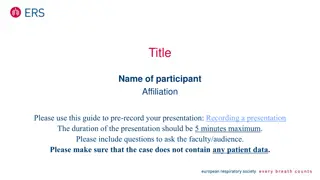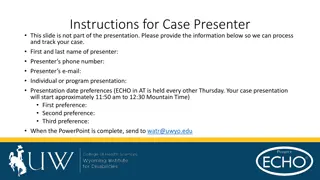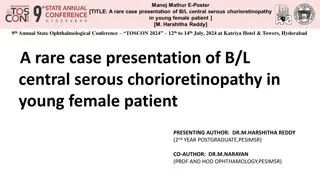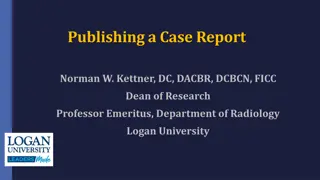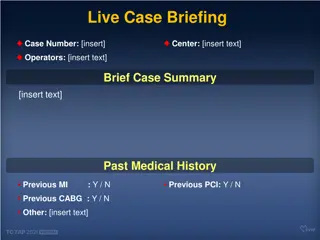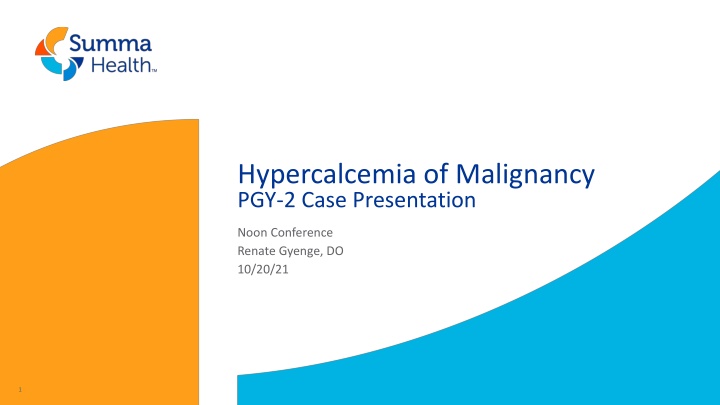
Hypercalcemia of Malignancy in a Case Presentation
Explore a case presentation of hypercalcemia of malignancy in a 41-year-old male with a history of oral squamous cell carcinoma. Delve into the disease pathogenesis, differential diagnosis, diagnostic criteria, treatment options, and patient updates, providing valuable insights into this complex medical condition.
Download Presentation

Please find below an Image/Link to download the presentation.
The content on the website is provided AS IS for your information and personal use only. It may not be sold, licensed, or shared on other websites without obtaining consent from the author. If you encounter any issues during the download, it is possible that the publisher has removed the file from their server.
You are allowed to download the files provided on this website for personal or commercial use, subject to the condition that they are used lawfully. All files are the property of their respective owners.
The content on the website is provided AS IS for your information and personal use only. It may not be sold, licensed, or shared on other websites without obtaining consent from the author.
E N D
Presentation Transcript
Hypercalcemia of Malignancy PGY-2 Case Presentation Noon Conference Renate Gyenge, DO 10/20/21 1
Outline 1. Review Case 2. Discuss Disease Pathogenesis 3. Discuss Differential Diagnosis 4. Discuss Diagnostic Criteria 5. Discuss Treatment 6. Patient Update 2
History of Present Illness 41 y/o M, with PMHx of oral squamous cell carcinoma s/p resection/reconstruction/PEG/trach placement + chemo/radiation, and hx of ETOH/tobacco abuse, who presented to ACH ED on 9/13/21 with the complaint of 1- week progressive SOB, abdominal pain, R flank pain, N/V, and inability to tolerate tube feeds Prior to symptoms, patient usually consumed 6 cans of TF via PEG a day; currently down to 1 can, even after formula change Patient had a couple episodes of subjective fever/chills 2 days prior to admission but was not having these symptoms in the ED Patient stopped drinking ETOH after diagnosis of oral cancer 4
Past Medical History Hx of oral squamous cell carcinoma First noticed L lower lip nodule and had dental abscess 11/2020; biopsy of nodule by dentistry revealed squamous cell carcinoma and referred to plastic surgery, heme/onc, and rad/onc Metastatic work-up was negative in 3/2021 and cancer was thought to be locally advanced but amenable to resection Resection/reconstruction/PEG/trach placement on 3/8/2021 radical segmental mandibulectomy with radical neck dissection and free fibular mandible reconstruction Pathology revealed stage T4a N3b (multiple affected lymph nodes, extracapsular extension, and lymphovascular invasion with close margins) T4a N3b M0 (considered Stage IVA) ROMAN Mucositis Prevention Trial - accepted on 5/4/21 Adjuvant Cisplatin + radiation - 5/11/21 (completed 2/3 cycles due to fatigue/nausea) Hx of tobacco use chewing tobacco; quit when diagnosed with above Hx of ETOH use; quit when diagnosed with above 6
Past Surgical History Tympanostomy tube placement (date unknown) Hernia repair (date unknown) Radical L segmental mandibulectomy, floor of mouth resection, bilateral neck dissection, tracheostomy, PEG tube placement (3/8/21) Reconstruction of L mandibular defect, floor of mouth defect with free L fibula flap, free L ALT free flap, split thickness skin graft to both L leg and thigh donor sites, estlander flap and facial sling (3/8/21) Family History Cancer father/mother unknown type 7
Social history Smoking daily marijuana Alcohol reports previous alcohol use, but not currently Other Illicit drugs n/a Living situation currently lives alone, recently separated from wife few months ago, 10 y/o son lives with wife, mother is biggest support system and lives a few blocks away from him Occupation used to work in the plastics industry Home Medications Ondansetron 8
Review of Systems Constitutional: Negative for fevers or chills HENT: Positive for trouble swallowing (s/p PEG, able to only swallow water and meds but takes nutrition via PEG) Eyes: Negative for visual disturbance Respiratory: Positive for shortness of breath. Trach in place. Negative for chest tightness. Cardiovascular: Negative for chest pain Gastrointestinal: Positive for abdominal pain, constipation, nausea, and vomiting. Negative for diarrhea Genitourinary: Negative for difficulty urinating and dysuria Musculoskeletal: Positive for back pain Neurological: Negative for dizziness, weakness, numbness, and headaches Psychiatric/Behavioral: Negative for agitation and confusion 10
Physical exam Vitals: Temp: 98.0 F, HR 96, BP 133/78, RR 16, SpO2 98% on RA Constitutional: normal appearance, in no acute distress HEENT: L-side of face/jaw/neck with notable reconstruction, unable to open mouth entirely due to reconstruction, patient able to speak well, EOMI, PERLA, conjunctiva normal CV: RRR, normal pulses, no murmurs Lung: pulmonary effort normal, no respiratory distress, no appreciable lung sounds on R side, L side CTA Abdomen: BS present x4, abdomen soft, RUQ tenderness without guarding or rebound Extremities: No injuries, no swelling Neuro: A/Ox3, no focal deficits Integumentary: warm/dry, no rashes or wounds, PEG site without erythema/swelling 12
Labs on admission MCV: 84.5 RDW: 12 ANC: 14.8 133 32 93 15.4 16.6 398 131 34 1.17 3.4 43.6 Calcium corrected for albumin: 17.6 17.4 37 Lipase: 19 7.6 24 PTH: 5.6 (L) 3.8 114 25-OH Vit D: 16 (L) 0.6 14
Imaging CT abdomen/pelvis: 1. LargeR pleural effusion with extensive pleural thickening (with areas of fat density) with R lung collapse and shift of heart and mediastinum to the L 2. Fatty liver 3. L chest port, prior L thigh surgery, gastrostomy tube in place with nondistended stomach / GI tract 4. Lytic lesion of T10 anteriorly vertebral body appearing since prior CT of 2/23/21. Benign area of rounded sclerosis lateral to R SI joint unchanged 15
Hypercalcemia Overview Most common causes are hyperparathyroidism (adenoma, CKD) and malignancy Other causes: OTC (milk-alkali syndrome from calcium supplements), Vit D intoxication, prescription medications (lithium, thiazide, tamoxifen, theophylline, Vit A derivatives), hyperthyroidism, granulomatous diseases (sarcoid, TB), prolonged immobilization, familial hypocalciuric hypercalcemia (FHH), MEN 1 & 2A syndromes, metaphyseal chondrodysplasia, congenital lactase deficiency Levels Mild: ULN 12 mg/dL Moderate: 12-14 mg/dL Severe: >14 mg/dL Symptoms ( bones, stones, groans, psychiatric overtones ) Mild: Asymptomatic, constipation, fatigue, depression, bone pain Moderate: polyuria/polydipsia, dehydration, anorexia, nausea, muscle weakness, kidney stones Severe: lethargy, confusion/impaired memory, psychosis, stupor, coma, arrhythmia 18
Differential Fibromyalgia (abdominal pain, bone pain, fatigue) Osteoarthritis (bone pain) Autoimmune arthritis (bone pain) Somatoform disorder (abdominal pain, bone pain) Endometriosis (abdominal pain) IBS-C (abdominal pain, constipation) Diverticulosis (constipation) Nephrogenic Diabetes Insipidus (hypercalcemia causes osmotic diuresis) Kidney Stones (kidney stones) Depression (depression) Dementia (confusion, impaired memory/concentration) Psychiatric disorder (psychosis) 19
Diagnostic Criteria Confirm true hypercalcemia Correct for albumin or order ionized calcium (iCa) Corrected calcium = [serum calcium + 0.8(4 serum albumin)] Hyperalbuminemia: serum calcium is falsely elevated (aka pseudohypercalcemia) and iCa is often normal Seen in dehydration Hypoalbuminemia: serum calcium is falsely low and may look like it is within normal levels and iCa is often increased Seen in malnutrition or chronic illness Review HPI / clinical clues Work-up: initially obtain serum PTH, serum PTH-rP, serum 25-hydroxy Vit D, and serum 1,25-dihydroxy Vit D (calcitriol); proceed with appropriate work-up following above results and based on clinical picture 20
Hypercalcemia Work-up Algorithm: 21
Hypercalcemia of Malignancy Pathophysiology 22
Mechanisms of Hypercalcemia in Malignancy Mechanisms (most common to least common): 1. Tumor secretion of parathyroid hormone related peptide (PTH-rP) 2. Metastasis to bone, causing osteolytic changes and release of osteoclast activating factors 3. Tumor production of calcitriol (1,25-dihydroxy vitamin D) 4. Ectopic tumor secretion of PTH 23
Pathophysiology of Humoral Hypercalcemic of Malignancy (PTH-rP secretion) 1. The most common cause of hypercalcemia in setting of malignancy is through the PTH-rP producing mechanism This mechanism makes up 80% of all malignancy-induced hypercalcemia cases Most common in SCC,renal, bladder, breast, or ovarian cancers Acts just as PTH; causes bone resorption and distal tubular calcium reabsorption Thought to have been the mechanism of hypercalcemia in patient case (a PTH-rP was ordered but was unfortunate never done by outside facility) Labs findings: elevated serum PTH-rP, low serum PTH, low/normal serum calcitriol 24
Pathophysiology of Osteolytic Metastasis 2. The second most common mechanism of malignancy-derived hypercalcemia is through bone invasion Accounts for 20% of all malignancy-induced hypercalcemia cases Osteolytic metastasis cause bone destruction by osteoclast stimulation from factors produced by the tumor cells Seen most in breast cancers, MM, and some lymphomas Might have played a part in patient case as CT abdomen/pelvis showed T10 osteolytic lesion Lab findings: low serum PTH, low serum PTH-rP, low/normal serum calcitriol 25
Other mechanisms 3. Increased production of calcitriol Normally, the conversion of 25-hydroxy vitamin D to 1,25-dihydroxy vitamin D (calcitriol) occurs in the kidney and is under the control of PTH In certain malignancies, there is extrarenal production of calcitriol by malignant lymphocytes and macrophages Elevated serum calcitriol causes increased intestinal absorption of calcium enough to cause significant hypercalcemia Most seen in Hodgkin lymphoma, ovarian dysgerminoma, and lymphomatoid granulomatosis Lab findings: low serum PTH, elevated or normal serum PTH-rP, and high serum calcitriol Responds to glucocorticoid therapy 4. Ectopic PTH production Associated with small cell lung cancer, ovarian cancer, neuroectodermal tumor, papillary thyroid cancer, rhabdomyosarcomas, pancreatic cancers, and gastric carcinomas Rare Lab findings: high serum PTH, low serum PTH-rP, low/normal serum calcitriol 26
Utility of PTH-rP PTH-rP can be used as a tumor marker to see response to treatment Indicates a poor prognosis PTH-rP levels that are above 12 are predictive of decreased ability to reduce calcium levels and a recurrence within 14 days Patients who are able to normalize calcium with bisphosphonate therapy have better outcomes despite PTH-rP level 27
Treatment of acute hypercalcemia Mild hypercalcemia (ULN 12 mg/dL) with symptoms and moderate hypercalcemia (12-14 mg/dL) can be treated with IVF and medications IVF Bisphosphonates x1 dose (DOC zoledronic acid) Severe hypercalcemia (>14 mg/dL), or acute increase in calcium to any value, or unresponsive to mild tx: Aggressive IVF of 200-300 cc/hr Calcitonin for no more than 48 hrs due to development of tachyphylaxis (diminishing response to successive doses) Bisphosphonates x1 dose (DOC zoledronic acid) Loop diuretics Consider HD when calcium levels reach 18-20 mg/dL, when neurologic symptoms are present, or when renal failure occurs Treat underlying disease 28
Treatment for patient case IVF 300 cc/hr Calcitonin 300 units IV q6h for 48 hours total Zoledronic acid 5 mg IV x1 dose Thoracentesis 2L removed Fluid Studies: LDH 452, Total protein 4.6, pH: 7.82, Glucose 73, Gram stain (-) for organisms, Body fluid culture NGTD, Cytology with atypical mesothelial cells; favor reactive process PleurX drain placement Cytology with malignant cells identified; consistent with squamous cell carcinoma Symptomatic treatment pain control, stool softeners, antiemetics, restarted TF for nutrition, electrolyte repletion after refeeding syndrome Consults: heme/onc, palliative care, rad/onc Discharge Outpatient bisphosphonate therapy to prevent recurrence of hypercalcemia, palliative radiation to T10 lytic bone lesion, home care ordered to drain PleurX catheter PRN 29
Update on patient Discharge 9/21/21 (8-day admission) 10/1/21 CT scan ordered by rad/onc prior to palliative radiation of T10 lytic lesion 10/5/21 Outpatient heme/onc appointment Continued to have functional decline with intermittent confusion Plan made to transition to hospice 30
References 1. Lumachi, F., Brunello, A., Roma, A., Basso, U. Cancer-induced hypercalcemia. Anticancer Research. May 2009, 29(5) 1551-1555. 2. Shane, E., Irani, D. Hypercalcemia: Pathogenesis, clinical manifestations, differential diagnosis, and management. In: Primer on the Metabolic Bone Diseases and Disorders of Mineral Metabolism, 6, Favus MJ (Ed), American Society for Bone and Mineral Research, Washington, DC 2006. 3. American Cancer Society website 4. UpToDate 31
Questions? 32
Thank you! 33













